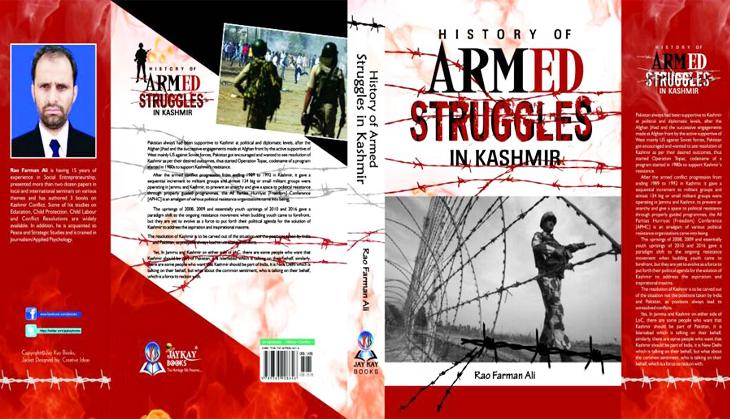Kashmir has a long history of armed rebellions, argues new book
_64013_730x419-m.jpg)
On 8 July – just about a month from now – it will be an year since the killing of Hizbul Mujahideen commander Burhan Muzaffar Wani, an event which plunged the Valley into one of its worst phases of unrest since the 1990s. Wani's killing and more recently that of another Hizb commander Sabzar Ahmad Bhat, brought a great deal of focus on the working of militant outfits in Kashmir. The mainstream Indian media and several policy-makers have tended to portray militant outfits in Kashmir as part of the phenomenon of global Islamist terrorism. This entirely ignores a parallel history to the militancy, one that lies in the past armed struggles in Kashmir.
It is in this context that Rao Farman Ali makes timely a intervention with his book History of Armed Struggles in Kashmir (Jay Kay Books). The biggest contribution this book makes is to highlight the indigenous character of armed resistance in Kashmir, from the 19th century till date.
The book narrates the history of four major armed struggles – the first being the rebellion against Dogra authoritarianism in the 19th century. Through his account of the Shawl-baaf agitation led by the shawl weavers against excessive taxation, compulsory weaving provisions and the system of Begaar, the author points out that armed resistance in Kashmir predates the first sepoy mutiny of 1857, leave alone the creation of Pakistan or the rise of pan-Islamism.
In 1847, hordes of Shawl-bafs managed to flee to neighbouring Punjab to escape exploitation. However, the then Maharaja Gulab Singh introduced the Rehdari system which meant sealing all escape routes and passes. Many of the shawl weavers chopped off their thumbs in order to escape the horrors of gruelling taxation.
The second phase of armed struggle that Farman Ali narrates, focussed on how certain indigenous political actors kept rejecting Shiekh Abdullah’s committment to the accession to India. For instance, the Mujahid Home Front carried out a number of attacks in 1951 to congregate the anti-India sentiment to a common point. As the terms of accession were eroded time again, a massive movement called Plebiscite Front (Mahaz Rai Shumari) was formed in 1955 led by Mirza Muhammad Afzal Begh.
It is pertinent to mention that Afzal Beigh had been a votary of accession to India. Around the same time various committees like Kashmir’s Liberation league, Kashmir Independence Committee were set up in Muzaffarabad to support an independent Kashmir. This period saw mushrooming of youth organisations rallying against Indian rule like the Student and Youth League, Revolutionary Youth Federation and number of other resistance cells. Farman Ali provides a balanced account of how the growth of these organisations was autonomous from Pakistan's Operation Gibraltar of 1965.

The third phase of indigenous armed struggle was the making of Al-Fatah in the 1970s. This was an indigenous guerrilla styled movement that put forward a four-stage programme of armed resistance in Kashmir.
The first stage was civil disobedience, the second stage was to create panic among armed forces in Kashmir and to stage ambushes, the third stage suggesting and recommending the raids upon depots and cantonments, the fourth stage was to attack large military convoys and depots.
This guerrilla group resorted to two robberies to raise finances for keeping the struggle running, because seeking financial help from Pakistan meant closing down the option of the complete freedom of Kashmir. Some of this money was used to develop long-term avenues of financing the group. Farman Ali’s analysis of Al-Fatah is in-depth and brings out those aspects of resistance movements in Kashmir which has largely been ignored in mainstream narratives.
The fourth section deals with the armed revolt in Kashmir 1988 onwards. He discusses the circumstances under which the armed militancy came about and demarcates the boundaries between the various militant groups. Since the difference between the JKLF and the Pro-Pakistan groups is explicit and needs no explanation, the crux of the chapter lies in documenting the proliferation of militant organisations in Kashmir, some because of ideology and some as a result of the battle between Indian and Pakistani intelligence agencies. However, militant groups did receive popular support.
They main drawback of the book is its exorbitant price – Rs 1495 – that may drive away the lay reader. The editing could also have been better as proofing errors and long-winded sentences often divert attention from the interesting factual details given in the book. Also, part of the book's introduction is a superfluous description of Kashmir's geographical position, its mountain ranges and the rock structures found in Valley. This isn't relevant to the theme of the book and is a throwback to the orientalist writings on Kashmir which presented it as a magical land of mountains and meadows.
In the concluding chapter of the book, Farman Ali suggests some Confidence-Building Measures (CBMs) which he believes will help build peace between India and Pakistan. This section doesn't really fall in the scope of the book. Moreover, most of the CBMs have been adequately covered in track-two discussions and they mostly follow global templates of conflict management that haven't yielded any results.
In totality, Farman Ali has made a wholesome contribution to the existing literature on Kashmir. The beauty of this text lies in how it makes a clear demarcation between the indigenous armed struggle in Kashmir and Pan Islamic movements on the other. The book is immaculate with respect to dates and details and it would have required lot of meticulousness in locating the oral sources which Farman Ali uses to substantiate his arguments.
First published: 6 June 2017, 20:37 IST





![BJP's Kapil Mishra recreates Shankar Mahadevan’s ‘Breathless’ song to highlight Delhi pollution [WATCH] BJP's Kapil Mishra recreates Shankar Mahadevan’s ‘Breathless’ song to highlight Delhi pollution [WATCH]](https://images.catchnews.com/upload/2022/11/03/kapil-mishra_240884_300x172.png)

![Anupam Kher shares pictures of his toned body on 67th birthday [MUST SEE] Anupam Kher shares pictures of his toned body on 67th birthday [MUST SEE]](https://images.catchnews.com/upload/2022/03/07/Anupam_kher_231145_300x172.jpg)






